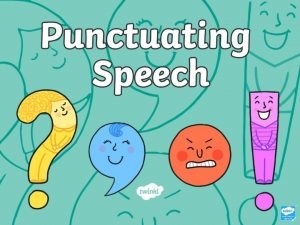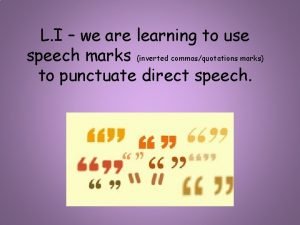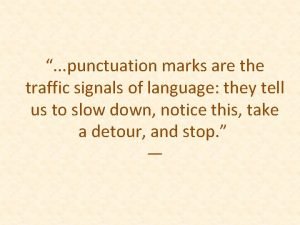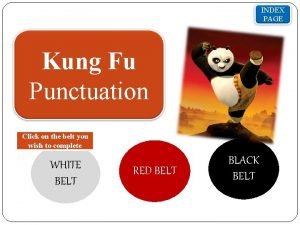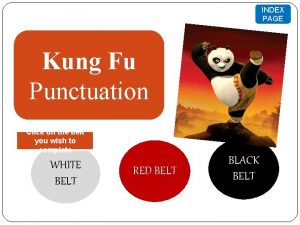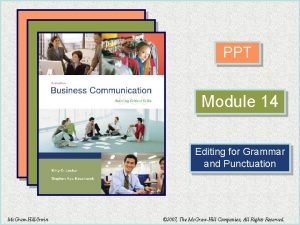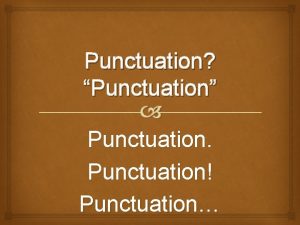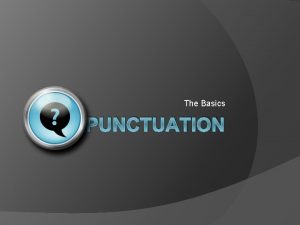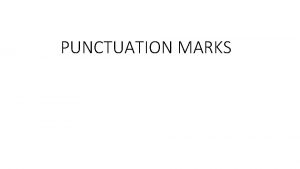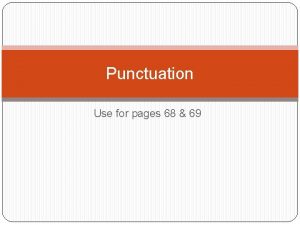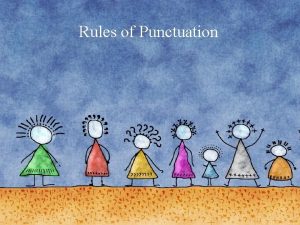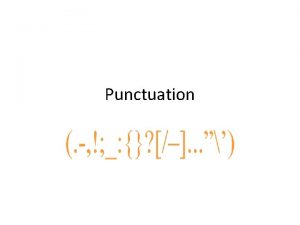Punctuation Marks We use punctuation marks in written









- Slides: 9

Punctuation Marks Ø We use punctuation marks in written text, chiefly to indicate breaks within sentences or between sentences. They help to make the meaning clear. Some punctuation marks indicate a stop at the end of a sentence. These are: 1. The full stop (. ), which we put at the end of • • declarative sentences and some imperative sentences: The dog ran away. Please close the door.

2. the question mark (? ), which we put at the end of interrogative sentences and other questions: • What time is it? • Jan is very attractive, isn’t he? • When did you come? 3. the exclamation mark (!), which we put at the end of exclamatory sentences and some imperative sentences: • What a mess! • Come here!

Some punctuation marks indicate a pause in the middle of a sentence. These are: 1. The comma (, ), which we use to separate clauses or items in lists: • If it rains, the party will be held indoors. • France, Italy, Germany and Spain are all countries in Europe.

2. The semi-colon (; ), which we use to link two sentences that are closely connected in meaning: • My old jeans have holes in the knees; I need a new pair. • Siar failed the exam; he had not done enough revision.

3. The colon (: ), which we use to introduce a list or a piece of dialogue in a play: • You will need the following ingredients: flour, sugar, eggs, and butter. • Siar: Did you enjoy your trip to the museum? • Wahid: Yes, I saw lots of interesting things there.

Some punctuation marks are used for other purposes, such as: 1. Quotation marks (‘ ‘ or “ “), also called inverted commas, which we use in pairs for direct speech, or to draw attention to a particular word: • Ahmad said, “I lost my mobile”. • The word ‘light’ has many different meanings.

2. The apostrophe (‘), which we use in possessive forms and contractions: • That is my brother’s house. • She didn’t know the answer. 3. The hyphen (-), which links words in some compound nouns, numbers and fractions: • Fazil is my brother-in-law. • Seventy-five per cent is the same as threequarters.

4. The dash ( • • 5. • • ), which introduces a piece of extra information: This is a digital camera it doesn’t use film. Ahmad chose the steak the most expensive item on the menu. Brackets ( ), also called parentheses, which we use in pairs around a piece of extra information: Siar chose the steak (the most expensive item on the menu). Chief Executive Officer (CEO).

6. Ellipsis points or dots (…), which show that something is omitted or unfinished intentionally: The rules clearly say that ‘Dogs are not allowed … on the beach’. • If I tell you the truth you will … •
 Reported speech
Reported speech Formatting quotations and dialogue
Formatting quotations and dialogue Put the correct punctuation marks in these sentences
Put the correct punctuation marks in these sentences Punctuation marks are like traffic signs. this sentence is
Punctuation marks are like traffic signs. this sentence is Kung fu punctuation speech marks
Kung fu punctuation speech marks Punctuation marks make meaning clear.
Punctuation marks make meaning clear. Put the correct punctuation marks in these sentences
Put the correct punctuation marks in these sentences Punctuation kung fu
Punctuation kung fu 14 punctuation marks ppt
14 punctuation marks ppt When do you use exclamation marks
When do you use exclamation marks
